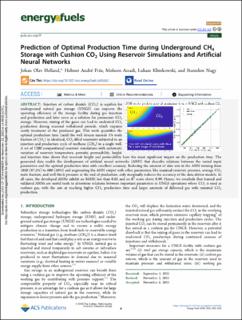| dc.contributor.author | Helland, Johan Olav | |
| dc.contributor.author | Friis, Helmer André | |
| dc.contributor.author | Assadi, Mohsen | |
| dc.contributor.author | Klimkowski, Lukasz | |
| dc.contributor.author | Nagy, Stanislaw | |
| dc.date.accessioned | 2024-03-14T09:53:38Z | |
| dc.date.available | 2024-03-14T09:53:38Z | |
| dc.date.created | 2023-11-23T08:33:25Z | |
| dc.date.issued | 2023 | |
| dc.identifier.citation | Helland, J. O., Friis, H. A., Assadi, M., Klimkowski, Ł., & Nagy, S. (2023). Prediction of Optimal Production Time during Underground CH4 Storage with Cushion CO2 Using Reservoir Simulations and Artificial Neural Networks. Energy & Fuels, 37(23), 19022-19038. | en_US |
| dc.identifier.issn | 0887-0624 | |
| dc.identifier.uri | https://hdl.handle.net/11250/3122348 | |
| dc.description.abstract | Injection of carbon dioxide (CO2) in aquifers for underground natural gas storage (UNGS) can improve the operating efficiency of the storage facility during gas injection and production and later serve as a solution for permanent CO2 storage. However, mixing of the gases can lead to undesired CO2 production during seasonal withdrawal periods, which requires costly treatment of the produced gas. This work quantifies the optimal production time (until the well stream exceeds 1% mole fraction of CO2) in idealized, CO2-filled reservoirs subjected to an injection and production cycle of methane (CH4) in a single well. A set of 1200 compositional reservoir simulations with systematic variation of reservoir temperature, porosity, permeability, height, and injection time shows that reservoir height and permeability have the most significant impact on the production time. The generated data enable the development of artificial neural networks (ANN) that describe relations between the varied input parameters and the optimal production time with excellent accuracy. Reducing the amount of data sets in the ANN training from 1050 (87.5%) to 600 (50%) and augmenting the ANN output with other parameters, like maximal reservoir pressure, average CO2 mole fraction, and well-block pressure at the end of production, only marginally reduces the accuracy of the data-driven models. In all cases, the developed ANNs exhibit an RMSE less than 0.02 and an R2 score above 0.99. Hence, we conclude that trained and validated ANNs are useful tools to determine relations between important parameters in UNGS operations where CO2 is used as cushion gas, with the aim at reaching higher CH4 production time and larger amounts of delivered gas with minimal CO2 production. | en_US |
| dc.language.iso | eng | en_US |
| dc.publisher | American Chemical Society | en_US |
| dc.rights | Navngivelse 4.0 Internasjonal | * |
| dc.rights.uri | http://creativecommons.org/licenses/by/4.0/deed.no | * |
| dc.title | Prediction of Optimal Production Time during Underground CH4 Storage with Cushion CO2 Using Reservoir Simulations and Artificial Neural Networks | en_US |
| dc.type | Peer reviewed | en_US |
| dc.type | Journal article | en_US |
| dc.description.version | publishedVersion | en_US |
| dc.rights.holder | The authors | en_US |
| dc.subject.nsi | VDP::Matematikk og Naturvitenskap: 400::Kjemi: 440 | en_US |
| dc.source.pagenumber | 17 | en_US |
| dc.source.journal | Energy & Fuels | en_US |
| dc.identifier.doi | 10.1021/acs.energyfuels.3c03382 | |
| dc.identifier.cristin | 2200656 | |
| cristin.ispublished | true | |
| cristin.fulltext | original | |
| cristin.qualitycode | 2 | |

